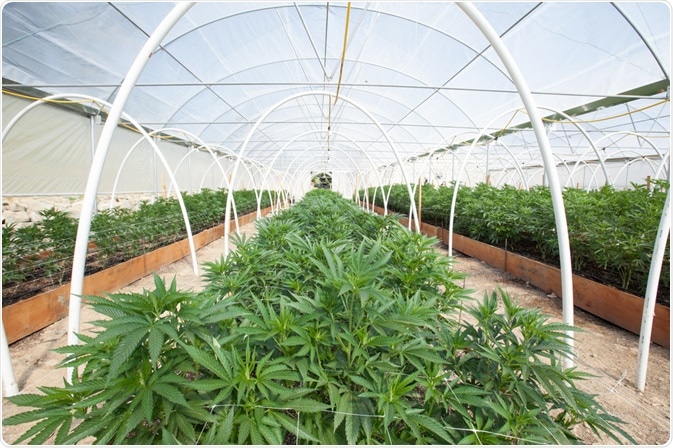A meta-analysis of cannabis cultivation showed that plant density, light intensity, and fertilization are the major contributors to cannabis yield, with pot size, light type, and duration of the flowering period representing potential predictors of THC build-up.
The aim of the research was to identify the main factors that influence yield per plant, per square meter, and per watt of lighting electricity.
 Image Credit: Canna Obscura/Shutterstock.com
Image Credit: Canna Obscura/Shutterstock.com
The analysis provides insights into the role of light-related factors and growth-promoting rhizobacteria to improve production methods that return high yields and minimize energy demand.
The study also describes how currently available genomics and transcriptomics data can be used to improve our understanding of the cannabis plant. The team also outlines how diversification of cannabis growth will enable growth promotion, regulation of cannabinoid biosynthesis, and biocontrol.
Changing attitudes to cannabis cultivation
The demand for industrial-scale production of high yield cannabis is expected to increase with the legalization of medical and/or recreational cannabis across many jurisdictions.
The cultivation of cannabis is driven largely by the demand for tetrahydrocannabinol (THC) and cannabidiol (CBD), which produce both beneficial and adverse effects in humans.
The strict control of cannabis crop has left scientific research with a considerable knowledge gap. As such, there is currently a yield gap; the maximum flower yield compared to current yields, as well as variability in quality which is dependent on cannabinoid concentration and profile.
The Knowledge Gap: What We Don’t Know About Cannabis
Currently, reported yields in Canada are 3.36 to 3590g dry flower m-2, yet it is unclear whether this is the maximum possible yield, what conditions optimize high yields, and whether the most relevant yield is obtained from flowers or the whole plant.
Current research has detailed the genotypes, metabolomic profiles, chemotype and diversity existing cannabis strain. Moreover, there is a body of research aimed at closing the yield gap which provided a good starting point for Bacer et al.
From their meta-analysis, the team examined the effect of cannabis genotypes and production conditions on several variables: yield per plant, per square meter and per watt (W) of lighting, and THC and CBD yield per plant and per square meter.
What Conditions Optimise Cannabis Yield and Quality?
Data was collected by Bacer's team for each treatment means, based on several variables that encompassed plant density variety and flowering stage, light intensity and source, photosynthetically active radiation, photoperiod during vegetative growth, and maximum growth temperature.
The yield was recorded as either yield per plant, yield m-2, and/or yield W-1; as was percentage THC and CBD in flowers. The meta-analysis revealed that to increase cannabis yield per square meter and per W light:
- Operate under low plant density (≤12 plants per square meter)
- Use a duration of flowering spanning 9 weeks
- Use HPS lamps which enables chlorophyll to absorb optimally
- Adopt a fertilizing regime,
- Manipulate the light intensity to balance high levels of energy efficiency with THC and CBD accumulation.
Bacer et al. also detailed the variety of Species of Cannabis plants, particularly the genomic and transcriptomic distinctions that can be made. They note that the available genome information is limited, particularly as it lacks metadata to enable the research community to make full use of the information.
The team further discussed the impact of the advent of genome editing technologies which they predict will greatly improve Cannabis cultivation. The team discussed the use of plant-growth-promoting rhizobacteria (PGPR) which can transform cannabis plants, producing a callus.
This undifferentiated mass of cells provides a source of cannabis in the biotechnology context. However, the team notes that the primary challenge lies in regenerating plants from the transformed callus.
Whilst the team’s meta-analysis was able to identify some key factors that contribute to cannabis yields, there were limitations associated with their study. Namely, only three studies were included and there remains an unclear relationship between flower and cannabinoid yields. Bacer also points out that the type impacts both flower and CBD yields which suggests light intensity reporting as W m−2 is inadequate.
Optimizing cannabis cultivation practices
The conclusions of the team’s meta-analysis reveal that research surrounding best practices for cannabis cultivation is lacking; whilst knowledge of industrial growing conditions has been reviewed, comparisons of productivity based on growing methods remains unclear. Further, attaining high frequency of growth cycles remains a challenge.
Bacer et al. suggest that growers could adopt agronomic practices, but it remains undetermined how these will influence medical/recreational cannabis quality.
Finally, the researchers point to the use of plant-growth-promoting rhizobacteria in cannabis production as evidenced by several studies across multiple strains. Their effects range from increased flower yield per plant to increased cannabinoid yield and reducing yield losses due to plant pathogens.
Conflicts of interest
GR is Chief Executive Officer of Ravenquest Biomed, Inc., a company that produces and sells cannabis products; DS and OW conduct research in collaboration with this company, where the research is funded through the Natural Sciences and Engineering Research Council which levers industrial funding.
The remaining authors declare that the research was conducted in the absence of any commercial or financial relationships that could be construed as a potential conflict of interest.
Further Reading